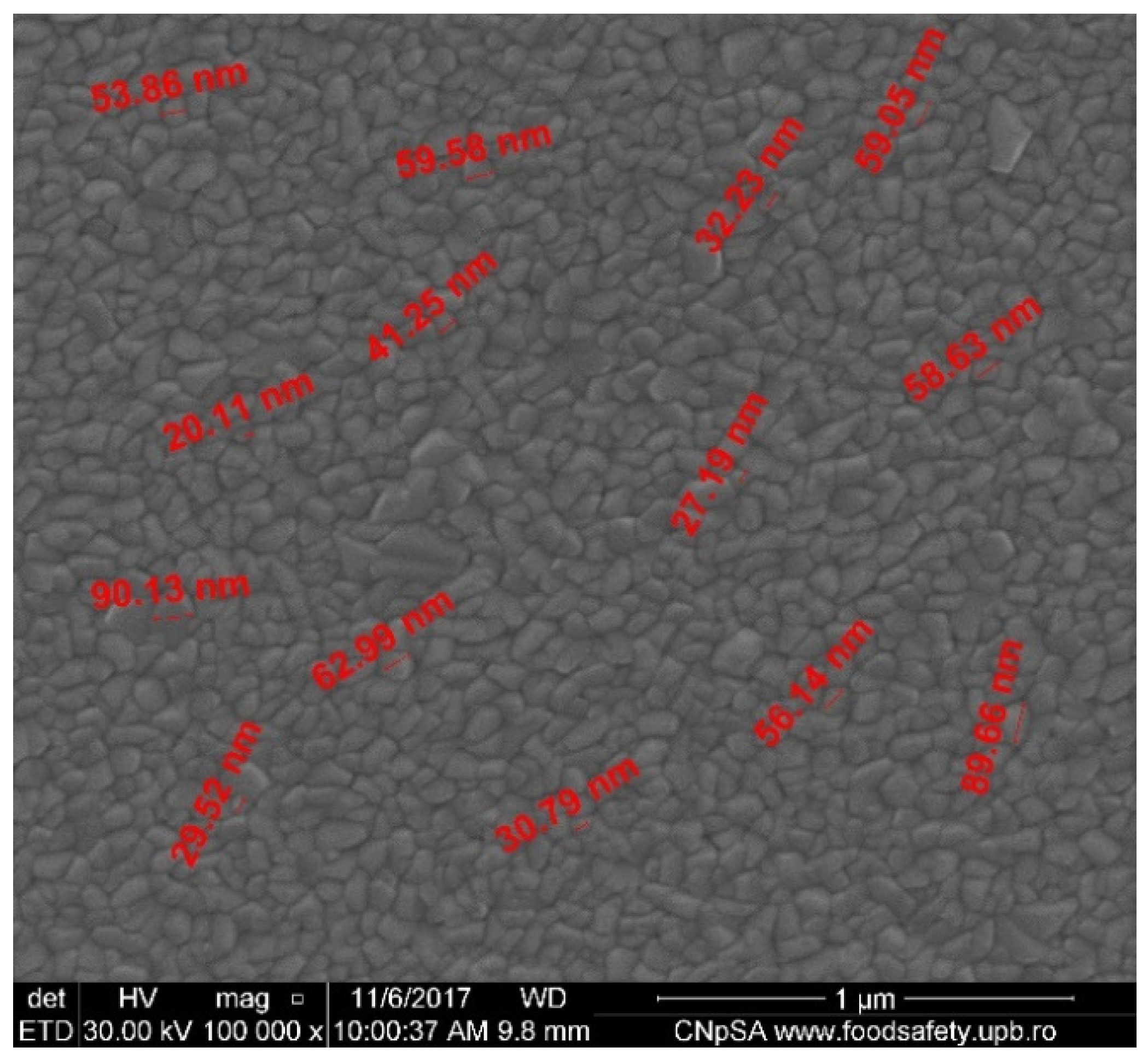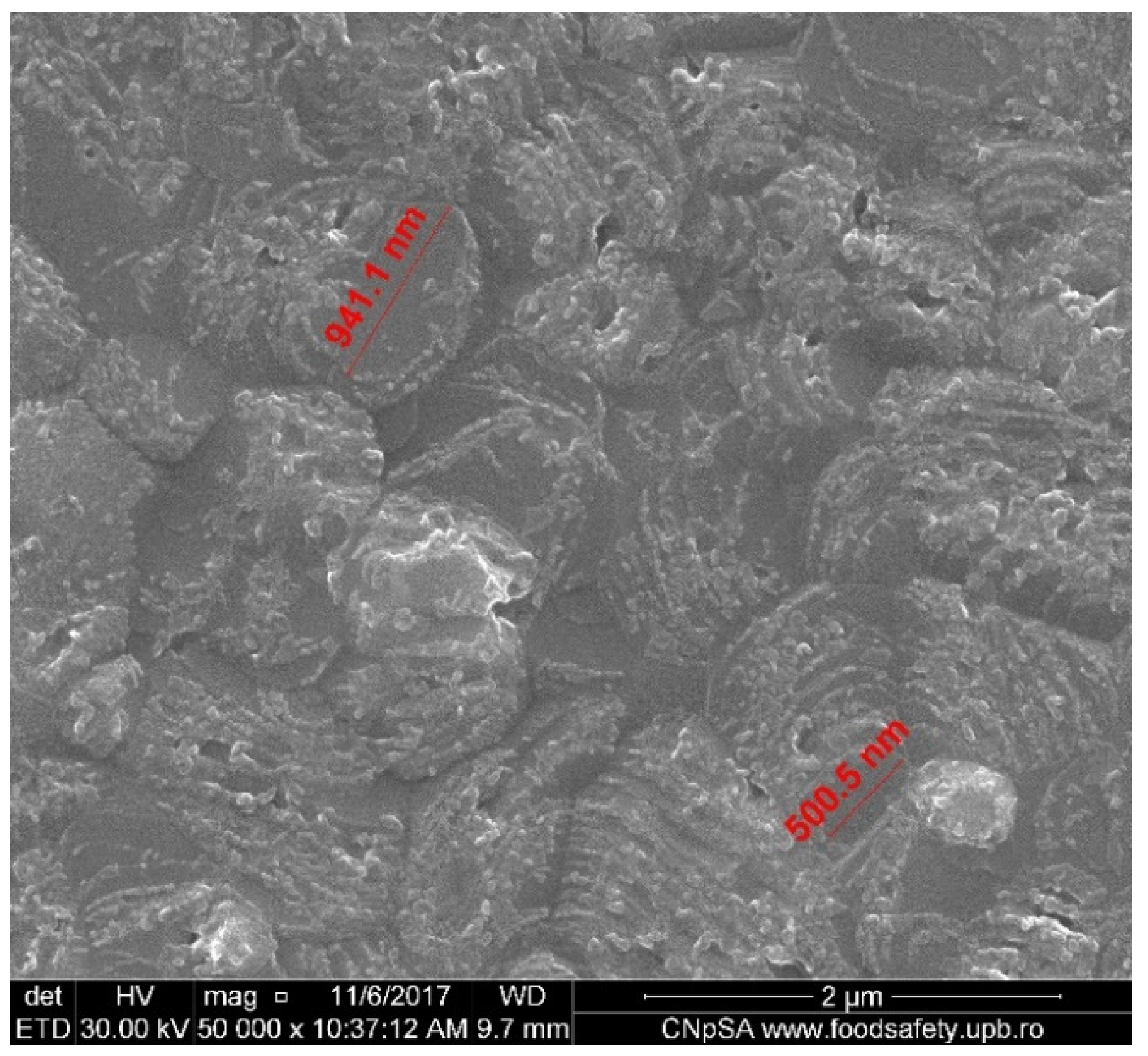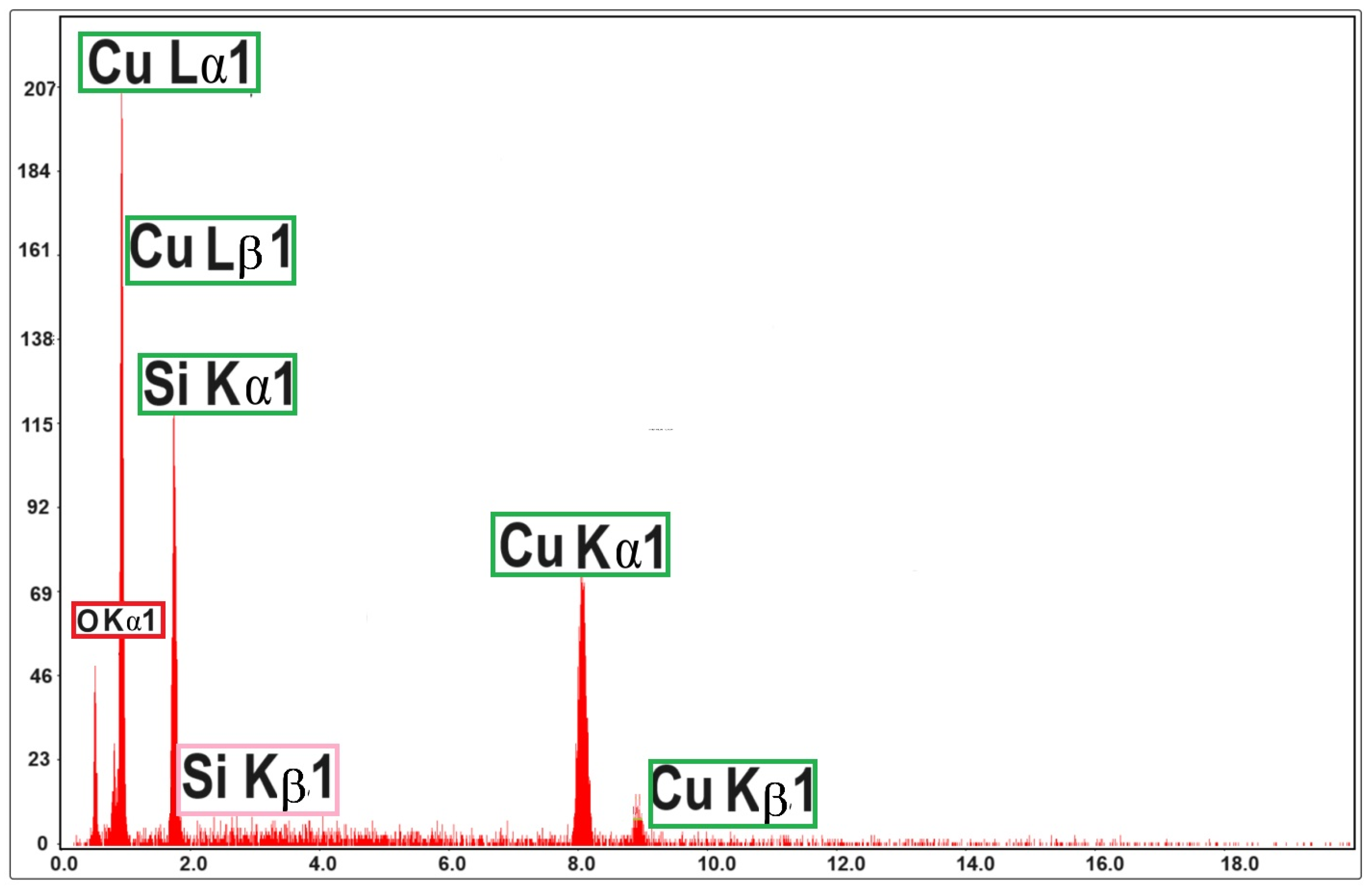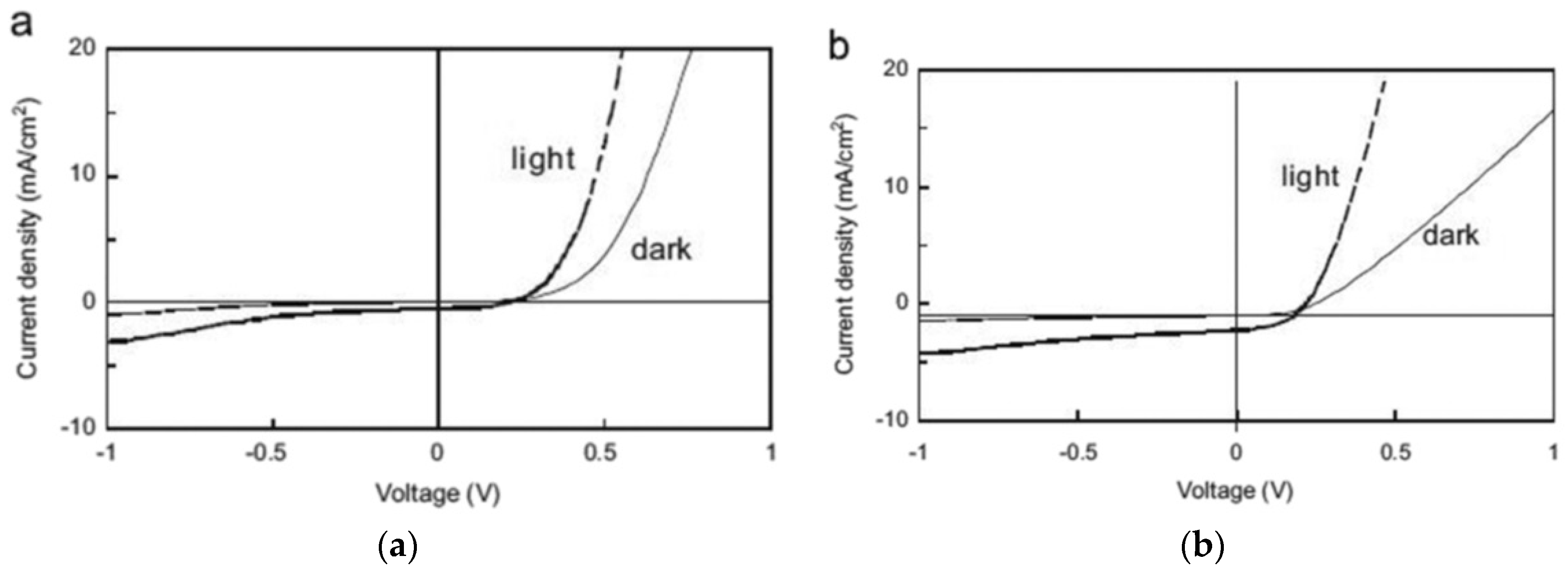On Numerical Modelling and an Experimental Approach to Heterojunction Tandem Solar Cells Based on Si and Cu2O/ZnO—Results and Perspectives
Abstract
1. Introduction
1.1. Metal Oxide Tandem Heterojunction Solar Cells
1.2. III–V Tandem Solar Cells
Plasmonic Solar Cells
1.3. Perovskite Tandem Solar Cells
2. The Article’s Structure, Methodology, and Novelty
- (1)
- The introduction discusses three advanced architectural solutions with different material for tandem solar cells;
- (2)
- The fundamental idea of the analysed SHTSCs based on Cu2O and ZnO metal oxides is presented;
- (3)
- The experimental approach is represented by the following items: (a) deposition of Cu2O thin films with a sputtering system, (b) morphological and optical characterization of Cu2O thin films, and (c) physical parameters of Cu2O thin films;
- (4)
- Numerical modelling: (i) five main simulation software tools for the top and bottom subcells are discussed; (ii) experimental and simulated EQE and J–V curves are studied; (iii) interface defects are analysed;
- (5)
- The stability and reliability of silicon heterojunction tandem solar cells (SHTSCs) is discussed;
- (6)
- Conclusions and perspectives are highlighted.
3. The Fundamental Idea of SHTSCs
4. SHTSC Experimental Approach: Deposition, Characterization, and Physical Parameters of Cu2O Films
4.1. Cu2O Films Deposition by a Sputtering System
4.2. Morphological Characterization of Cu2O Films
4.3. Optical Characterization of Cu2O Films
4.4. Physical Parameters of Cu2O Films
5. SHTSC Numerical Modelling—Analysis of Interface Defects
5.1. Simulation Results for Electrical Modelling of SHTSC
- (a)
- The electrical modelling in Afors-Het solved the semiconductor equations, the Poisson equation, and the transport equation for electrons and holes by the finite-difference method. This structure was used to analyse the influence of doping for the component layers on the essential parameters of the top subcell;
- (b)
- In the simulation with wxAmps, a performance assessment of the metal oxide subcell was performed for optimized thicknesses of the Cu2O and ZnO layers taking into account the subcell’s electric parameters, respectively: the fill factor, the short-circuit current, the open-circuit voltage, and the conversion efficiency of the implemented solar device as a function of temperature;
- (c)
- The numerical model developed in Silvaco Atlas was a complex one that aimed to optimize the structure of the subcell but also the material parameters for its layers. Using Silvaco Atlas, several values for the doping level were simulated, respectively, at the level of defect density presented in the copper oxide subcell. Based on the obtained results, the electric parameters of the solar subcell were established for different values of defect density of the Cu2O layer;
- (d)
- A titanium dioxide (TiO2) thin film can act as a buffer layer in a Cu2O/ZnO solar cell based on the following noticed properties: (1) high optical transparency; (2) good transport properties; and (3) a wide band gap. The effect of this buffer layer on the characteristics of ZnO/Cu2O SC was considered very important for improving the performance of such solar devices.
- A.
- The simulated SHTSC without the TiO2 buffer layer presented the following SC output parameters: Voc = 0.65 V, Jsc = 7.81 mA cm−2, FF = 39.1%, and η = 2.54%. The obtained efficiency was in agreement with the experimental value of Minami et al. [19]; our work was used for comparison and analysis of the research on simulated SHTSC without and with the TiO2 buffer layer, respectively.
- B.
- A remarkable improvement was obtained by introducing the intermediate TiO2 buffer layer between ZnO/AZO and Cu2O. As a result, Voc, Jsc, FF, and η had the following values: 0.84 V, 8.74 mA cm−2, 50.4%, and 5.02%, respectively.
- (e)
- For the silicon bottom subcell, a numerical model was developed using the PC1D/Quokka 2 platform, and the model was then compared to the experimental plot [3,26,34]. Therefore, a predicted model of the Si subcell was established. Based on the model improvement, a simulated external quantum efficiency (EQE) plot was calculated to compare with the experimental EQE plot (Figure 9a). At the same time, the J–V graph was studied; it can be observed that the simulated graph is very close to the experimental one (Figure 9b).
5.2. Analysis of Interface Defects in SHTSCs
- (1)
- The SC electrical parameters were obtained based on the DD (defect density) of the IDL (interface defect layer) for different thicknesses.
- (2)
- The behaviour of the conduction-band energy for different DD values of the IDL (Figure 10a) could be studied. An important increase was observed in the bandgap between the buffer layer and the IDL for a DD above 1019 cm−3, resulting in decreased SC performance.
- (3)
- The parameters of the analysed SHTSC could be investigated according to the DD of the Cu2O layer in the SC.
- (4)
- The behaviour of the conduction-band energy for different Cu2O-layer acceptor concentrations could be studied (Figure 10b). There was a significant increase in the bandgap for a concentration above 1016 cm−3 that provoked an SC performance decrease.
- (5)
- The simulated results showed a significant decrease in SC performance for a DD of the Cu2O layer over 1013 cm−3. That is why the value of DD for the Cu2O layer was set at 1013 cm−3.
6. Stability and Reliability of Si Heterojunction Tandem Solar Cells (SHTSC)
7. Conclusions and Perspectives
7.1. Conclusions
- (a)
- this study developed an improved structure for a tandem SC based on a ZnO (AZO)/TiO2/Cu2O heterojunction top subcell combined with a c-Si solar bottom subcell;
- (b)
- (c)
- the design and optimization of SHTSCs was furthered based on particular mathematical models that used physical parameters obtained through experimental characterisation;
- (d)
- the experimental implementation of metal oxide SHTSCs was described in terms of the J–V characteristics;
- (e)
- a theoretical SHTSC conversion efficiency greater than 30% was noted;
- (f)
- the analysis of defect density (DD) based on numerical modelling showed how the interface defects and band offsets of the studied SHTSC reduced the top subcell’s performance;
- (g)
- SHTSC stability was discussed with an emphasis on the degradation rates of different materials and structures of the SC;
- (h)
- the reliability of the SHTSC and corresponding BIPV system was discussed using RAMS and HASS simulation tools, stressing two important parameters: failure rate and time-dependent degradation.
7.2. Perspectives
- (a)
- the development of 4-terminal SCs characterized by a control of interface properties would allow a reduction in the defect contribution;
- (b)
- the development of high-performance carrier-selective passivating contacts based on a tunnelling oxide layer combined with a conductive organic polymer could improve the performance of SHTSCs.
- (c)
- (d)
- the development of reliable and efficient perovskite SCs requires a multilevel approach to optimize the performance of individual layers in each cell separately.
Author Contributions
Funding
Institutional Review Board Statement
Informed Consent Statement
Data Availability Statement
Conflicts of Interest
References
- Saif, O.M.; Zekry, A.H.; Abouelatta, M.; Shaker, A. A Comprehensive Review of Tandem Solar Cells Integrated on Silicon Substrate: III/V vs. Perovskite. Silicon 2023, 15, 6329–6347. [Google Scholar] [CrossRef]
- Wilson, G.M.; Al-Jassim, M.; Metzger, W.K.; Glunz, S.W.; Verlinden, P.; Xiong, G.; Mansfield, L.M.; Stanbery, B.J.; Zhu, K.; Yan, Y.; et al. The 2020 photovoltaic technologies roadmap. J. Phys. D Appl. Phys. 2020, 53, 493001. [Google Scholar] [CrossRef]
- Fara, L.; Chilibon, I.; Nordseth, Ø.; Craciunescu, D.; Savastru, D.; Vasiliu, C.; Baschir, L.; Fara, S.; Kumar, R.; Monakhov, E.; et al. Complex Investigation of High Efficiency and Reliable Heterojunction Solar Cell based on an Improved Cu2O Absorber Layer. Energies 2020, 13, 4667. [Google Scholar] [CrossRef]
- Nordseth, Ø.; Kumar, R.; Bergum, K.; Fara, L.; Foss, S.E.; Haug, H.; Dragan, F.; Craciunescu, D.; Sterian, P.; Chilibon, I.; et al. Optical Analysis of a ZnO/Cu2O Subcell in a Silicon-Based Tandem Heterojunction Solar Cell. Green Sustain. Chem. (GSC) 2017, 7, 57–69. [Google Scholar] [CrossRef]
- Takiguchi, Y.; Miyajima, S. Device simulation of cuprous oxide heterojunction solar cells. Jpn. J. Appl. Phys. 2015, 54, 112303. [Google Scholar] [CrossRef]
- Wong, T.K.S.; Zhuk, S.; Masudy-Panah, S.; Dalapati, G.K. Current status and future prospects of copper oxide heterojunction solar cells. Materials 2016, 9, 271. [Google Scholar] [CrossRef]
- Fara, L.; Chilibon, I.; Craciunescu, D.; Diaconu, A.; Fara, S. Review, Heterojunction Tandem Solar Cells on Si-Based Metal Oxides. Energies 2023, 16, 3033. [Google Scholar] [CrossRef]
- Wei, H.; Gong, H.; Wang, Y.; Hu, X.; Chen, L.; Xu, H.; Liu, P.; Cao, B. Three kinds of Cu2O/ZnO heterostructure solar cells fabricated with electrochemical deposition and their structure-related photovoltaic properties. CrystEngComm 2011, 13, 6065–6070. [Google Scholar] [CrossRef]
- Heinrich, M.; Kuhn, T.E.; Dimroth, F.; Würfel, U.; Goldschmidt, J.C.; Powalla, M.; Glunz, S.W.; Neuhaus, D.H. A comparison of different solar cell technologies for integrated photovoltaics. In Proceedings of the 37th European Photovoltaic Solar Energy Conference and Exhibition, EU PVSEC, Online, 7–11 September 2020; pp. 1984–1994. [Google Scholar]
- Zaidi, S.H. Metallization in Solar Cell. In Crystalline Silicon Solar Cells; Springer: Cham, Switzerland, 2021; pp. 125–200. [Google Scholar] [CrossRef]
- Ashouri, A.A.; Köhnen, E.; Li, B.; Magomedov, A.; Hempel, H.; Caprioglio, P.; Márquez, J.A.; Morales Vilches, A.B.; Kasparavicius, E.; Smith, J.A.; et al. Monolithic perovskite/silicon tandem solar cell with >29% efficiency by enhanced hole extraction. Science 2020, 370, 1300–1309. [Google Scholar] [CrossRef]
- Yue, Z.; Cai, B.; Wang, L.; Wang, X.; Gu, M. Intrinsically core-shell plasmonic dielectric nanostructures with ultrahigh refractive index. Sci. Adv. 2016, 2, e1501536. [Google Scholar] [CrossRef]
- Yu, P.; Yao, Y.; Wu, J.; Niu, X.; Rogach, A.L.; Wang, Z. Effects of Plasmonic Metal Core -Dielectric Shell Nanoparticles on the Broadband Light Absorption Enhancement in Thin Film Solar Cells. Sci. Rep. 2017, 7, 7696. [Google Scholar] [CrossRef] [PubMed]
- Ferry, V.E.; Munday, J.N.; Atwater, H.A. Design Considerations for Plasmonic Photovoltaics. Adv. Mater. 2010, 22, 4794–4808. [Google Scholar] [CrossRef] [PubMed]
- Laska, M.; Krzemińska, Z.; Kluczyk-Korch, K.; Schaadt, D.; Popko, E.; Jacak, W.A.; Jacak, J.E. Methods for increasing efficiency should be indicated, including nano-metallization. Nano Energy 2020, 75, 104751. [Google Scholar] [CrossRef]
- Wu, M.; Sun, D.; Tan, C.; Tian, X.; Huang, Y. Al-Doped ZnO Monolayer as a Promising Transparent Electrode Material: A First-Principles Study. Materials 2017, 10, 359. [Google Scholar] [CrossRef] [PubMed]
- Svensson, B.G.; Pearton, S.J.; Jagadish, C. Oxide Semiconductors, Semiconductors and Semimetals; Elsevier & Academic Press: Amsterdam, The Netherlands, 2013. [Google Scholar]
- Minami, T.; Nishi, Y.; Miyata, T. Efficiency enhancement using a Zn1−x Gex -O thin film as an n-type window layer in Cu2O-based heterojunction solar cells. Appl. Phys. Express 2016, 9, 052301. [Google Scholar] [CrossRef]
- Minami, T.; Miyata, T.; Nishi, Y. Cu2O-based heterojunction solar cells with an Al-doped ZnO/oxide semiconductor/thermally oxidized Cu2O sheet structure. Sol. Energy 2014, 105, 206–217. [Google Scholar] [CrossRef]
- Gan, J.; Venkatachalapathy, V.; Svensson, B.G.; Monakhov, E.V. Influence of Target Power on Properties of CuxO Thin Films Prepared by Reactive Radio Frequency Magnetron Sputtering. Thin Solid Film. 2015, 594, 250–255. [Google Scholar] [CrossRef]
- Ishizuka, S.; Maruyama, T.; Akimoto, K. Thin-film deposition of Cu2O by reactive radiofrequency magnetron sputtering. Jpn. J. Appl. Phys. 2000, 39, L786–L788. [Google Scholar] [CrossRef]
- Nordseth, Ø.; Chilibon, I.; Kumar, R.; Bergum, K.; Vasiliu, C.; Iordanescu, R.; Baschir, L.; Savastru, D.; Kiss, A.; Parau, A.; et al. Characterization of Cuprous Oxide Thin Films Prepared by Reactive Direct Current Magnetron Sputtering. Sens. Transducers 2018, 220, 53–60. [Google Scholar]
- Read, D.T.; Cheng, Y.W.; Geiss, R. Morphology, microstructure, and mechanical properties of a copper electrodeposit. Microelectron. Eng. 2004, 75, 63–70. [Google Scholar] [CrossRef]
- Chilibon, I.; Fara, L.; Nordseth, Ø.; Kumar, R.; Svensscen, B.G.; Dumitru, C.; Dragan, F.; Muscurel, V.; Vasiliu, C.; Stefan, R. Characterization of Cuprous Oxide Thin Films used in solar cells by fluorescence and FTIR spectroscopy. AOSR Ann. 2018, 11, 61–69. [Google Scholar]
- Chilibon, I.; Fara, L.; Nordseth, Ø.; Kumar, R.; Svensson, B.G.; Dumitru, C.; Dragan, F.; Muscurel, V.; Vasiliu, C.; Parau, A. Structural and electrical analysis of Cu2O layers for solar cell application. AOSR Ann. 2018, 11, 53–60. [Google Scholar]
- Nordseth, Ø.; Foss, S.E.; Svensson, B.G.; Kumar, R.; Chilibon, I.; Vasiliu, C.; Iordanescu, R.; Baschir, L.; Savastru, D.; Kiss, A.; et al. Cu2O photosensitive thin films for solar cell application. In Proceedings of the Sensor Devices, Rome, Italy, 10–14 September 2017; pp. 47–52. [Google Scholar]
- Elmahdy, M.M.; El-Shaer, A. Structural, optical and dielectric investigations of electrodeposited p-type Cu2O. J. Mater. Sci. Mater. Electron. 2019, 30, 19894–19905. [Google Scholar] [CrossRef]
- Nordseth, Ø.; Kumar, R.; Bergum, K.; Fara, L.; Chilibon, I.; Foss, S.E.; Monakhov, E.; Svensson, B.G. Silicon-based tandem solar cells Boosting the performance using non-toxic metal oxides. GIT Lab. J. 2017, 7–8, 25–27. [Google Scholar]
- Bergum, K.; Riise, H.N.; Gorantla, S.; Lindberg, P.F.; Jensen, I.J.T.; Gunnæs, A.E.; Galeckas, A.; Diplas, S.; Svensson, B.G.; Monakhov, E. Improving carrier transport in Cu2O thin films by rapid thermal annealing. J. Phys. Condens. Matter. 2018, 30, 075702. [Google Scholar] [CrossRef] [PubMed]
- Zhu, H.; Zhang, J.; Li, C.; Pan, F.; Wang, T.; Huang, B. Cu2O thin films deposited by reactive direct current magnetron sputtering. Thin Solid Films 2009, 517, 5700–5704. [Google Scholar] [CrossRef]
- Afors-Het 2.5.0. Available online: https://softdeluxe.com/Afors-Het-364558/download/ (accessed on 20 October 2022).
- Sliti, N.; Touihri, S.; Nguyen, N.D. Numerical modeling and analysis of AZO/Cu2O transparent solar cell with a TiO2 buffer layer. Eng. Res. Express 2023, 5, 025013. [Google Scholar] [CrossRef]
- Löckinger, J.; Nishiwaki, S.; Weiss, T.P.; Bissig, B.; Romanyuk, Y.E.; Buecheler, S.; Tiwar, A.N. TiO2 as intermediate buffer layer in Cu(In, Ga)Se2 solar cells. Sol. Energy Mater. Sol. Cells 2018, 174, 397–404. [Google Scholar] [CrossRef]
- Nordseth, Ø.; Kumar, R.; Bergum, K.; Fara, L.; Dumitru, C.; Craciunescu, D.; Dragan, F.; Chilibon, I.; Monakhov, E.; Foss, S.E.; et al. Metal oxide thin-film heterojunctions for photovoltaic applications. Materials 2018, 11, 2593. [Google Scholar] [CrossRef]
- Sawicka-Chudy, P.; Sibiński, M.; Rybak-Wilusz, E.; Cholewa, M.; Wisz, G.; Yavorskyi, R. Review of the development of copper oxides with titanium dioxide thin-film solar cells. AIP Adv. 2020, 10, 010701. [Google Scholar] [CrossRef]
- Malerba, C.; Biccari, F.; Ricardo, C.L.A.; D’Incau, M.; Scardi, P.; Mittiga, A. Absorption Coefficient of Bulk and Thin Film Cu2O. Sol. Energy Mater. Sol. Cells 2011, 95, 2848–2854. [Google Scholar] [CrossRef]
- Ichimura, M.; Kato, Y. Fabrication of TiO2/Cu2O heterojunction solar cells by electrophoretic deposition and electrodeposition. Mater. Sci. Semicond. Process. 2013, 16, 1538–1541. [Google Scholar] [CrossRef]
- Baccara, F. Defects and doping in Cu2O. Ph.D. Thesis, Universita di Roma, Roma, Italy, 2009. [Google Scholar]
- Brandt, R.E.; Young, M.; Park, H.H.; Dameron, A.; Chua, D.; Lee, Y.S.; Teeter, G.; Gordon, R.G.; Buonassisi, T. Band Offsets of N-Type Electron-Selective Contacts on Cuprous Oxide (Cu2O) for Photovoltaics. Appl. Phys. Lett. 2014, 105, 263901. [Google Scholar] [CrossRef]
- Wang, Y.; Miska, P.; Pilloud, D.; Horwat, D.; Mücklich, F.; Pierson, J.F. Transmittance Enhancement and Optical Band Gap Widening of Cu2O Thin Films after Air Annealing. J. Appl. Phys. 2014, 115, 073505. [Google Scholar] [CrossRef]
- Siol, S.; Hellmann, J.C.; Tilley, S.D.; Graetzel, M.; Morasch, J.; Deuermeier, J.; Jaegermann, W.; Klein, A. Band alignment engineering at Cu2O/ZnO hetero-interfaces. ASC Appl. Mater. Interfaces 2016, 8, 21824–21831. [Google Scholar] [CrossRef]
- White, T.P.; Lal, N.N.; Catchpole, K.R. Tandem Solar Cells Based on High Efficiency C-Si Bottom Cells. Top Cell Requirements for >30% Efficiency. IEEE J. Photovolt. 2014, 4, 208–214. [Google Scholar] [CrossRef]
- Jiang, K.; Yang, Y.; Yan, Z.; Huang, S.; Li, X.; Li, Z.; Zhou, Y.; Zhang, L.; Meng, F.; Liu, Z.; et al. Balance of efficiency and stability of silicon heterojunction solar cells. Sol. Energy Mater. Sol. Cells 2022, 243, 111801. [Google Scholar] [CrossRef]
- VDMA. Available online: https://itrpv.vdma.org/en/ (accessed on 10 July 2021).
- Krassowski, E.; Jaeckel, B.; Zeller, U.; Pander, M.; Schenk, P.; Hofmueller, E.; Hanifi, H. Reliability Evaluation of Photovoltaic Modules Fabricated from Treated Solar Cells by Laser-Enhanced Contact Optimization Process. Sol. RRL 2022, 6, 2100537. [Google Scholar] [CrossRef]
- Fara, L.; Craciunescu, D. Reliability analysis of photovoltaic systems for specific applications. In Reliability and Ecological Aspects of Photovoltaic Modules; Gok, A., Ed.; Intech Open: London, UK, 2020; pp. 79–92. [Google Scholar]
- Nandy, S.; Banerjee, A.N.; Fortunato, E.; Martins, R. A Review on Cu2O and CuI-Based p-Type Semiconducting Transparent Oxide Materials: Promising Candidates for New Generation Oxide Based Electronics. Rev. Adv. Sci. Eng. 2013, 2, 273–304. [Google Scholar] [CrossRef]
- Fara, L.; Yamaguchi, M. (Eds.) Advanced Solar Cell Materials, Technology, Modelling, and Simulation; IGI Global Publishing House: Hershey, PA, USA, 2013. [Google Scholar]
- Mitroi, R.; Ninulescu, V.; Fara, L. Performance optimization of solar cells based on heterojunctions with Cu2O: Numerical analysis. J. Energy Eng. 2017, 143, 04017005. [Google Scholar] [CrossRef]
- Zhang, D.; Soppe, W.; Schropp, R.E. Design of 4-Terminal Solar Modules Combining Thin-Film Wide-Bandgap Top Cells and C-Si Bottom Cells. Energy Procedia 2015, 77, 500–507. [Google Scholar] [CrossRef]
- Ehsan, R.; Zubair, A. Review on two-terminal and four-terminal crystalline-silicon/perovskite tandem solar cells; progress, challenges, and future perspectives. Energy Rep. 2022, 8, 5820–5851. [Google Scholar]
- Park, J.H.; Ji, S.G.; Park, I.J.; Hwang, S.K.; Lim, H.W.; Kim, J.Y. Sub-cell characterization of two-terminal perovskite/silicon tandem solar cells. Cell Rep. Phys. Sci. 2022, 3, 101076. [Google Scholar] [CrossRef]
- Chander, S.; Kant Tripathi, S. Recent advancement in efficient metal oxide-based flexible perovskite solar cells: A short review. Mater. Adv. 2022, 3, 7198–7211. [Google Scholar] [CrossRef]
- McMahon, W.E.; Geisz, J.F.; Buencuerpo, J.; Warren, E.L. A framework for comparing the energy production of photovoltaic modules using 2-, 3-, and 4-terminal tandem cell. Sustain. Energy Fuels 2023, 7, 461–470. [Google Scholar] [CrossRef]












| Parameters | Cu2O | TiO2 | ZnO/AZO |
|---|---|---|---|
| Electron affinity [eV] | 3.2 | 3.9 | 4.4 |
| Thickness [μm] | 2–15 | 0.01–0.1 | 0.2 |
| Dielectric constant | 7.6 | 10 | 9 |
| Band gap [eV] | 2.1 | 3.2 | 3.35 |
| Donor density [cm−3] | — | 5 × 1014–1 × 1017 | 1 × 1021 |
| Electron mobility [cm2 V−1 s−1] | 20 | 100 | 10 |
| Acceptor density [cm−3] | 5 × 1014–1 × 1017 | — | — |
| Hole mobility [cm2 V−1 s−1] | 10 | 25 | 5 |
| Density of state for VB (valence band) [cm−3] | 2.43 × 1019 | 2 × 1017 | 1.8 × 1019 |
| Density of state for CB (conduction band) [cm−3] | 1.34 × 1019 | 6 × 1017 | 2.2 × 1018 |
| Defect density [cm−3] | 5 × 1013–5 × 1015 | 1 × 1015 | 1 × 1018 |
| Parameters | Jsc [mA cm−2] | Voc [V] | FF [%] | η [%] |
|---|---|---|---|---|
| Cu2O/AZO | 7.81 | 0.65 | 39.1 | 2.54 |
| Cu2O/TiO2/AZO | 8.74 | 0.84 | 50.4 | 5.02 |
Disclaimer/Publisher’s Note: The statements, opinions and data contained in all publications are solely those of the individual author(s) and contributor(s) and not of MDPI and/or the editor(s). MDPI and/or the editor(s) disclaim responsibility for any injury to people or property resulting from any ideas, methods, instructions or products referred to in the content. |
© 2024 by the authors. Licensee MDPI, Basel, Switzerland. This article is an open access article distributed under the terms and conditions of the Creative Commons Attribution (CC BY) license (https://creativecommons.org/licenses/by/4.0/).
Share and Cite
Fara, L.; Chilibon, I.; Vasiliu, I.C.; Craciunescu, D.; Diaconu, A.; Fara, S. On Numerical Modelling and an Experimental Approach to Heterojunction Tandem Solar Cells Based on Si and Cu2O/ZnO—Results and Perspectives. Coatings 2024, 14, 244. https://doi.org/10.3390/coatings14030244
Fara L, Chilibon I, Vasiliu IC, Craciunescu D, Diaconu A, Fara S. On Numerical Modelling and an Experimental Approach to Heterojunction Tandem Solar Cells Based on Si and Cu2O/ZnO—Results and Perspectives. Coatings. 2024; 14(3):244. https://doi.org/10.3390/coatings14030244
Chicago/Turabian StyleFara, Laurentiu, Irinela Chilibon, Ileana Cristina Vasiliu, Dan Craciunescu, Alexandru Diaconu, and Silvian Fara. 2024. "On Numerical Modelling and an Experimental Approach to Heterojunction Tandem Solar Cells Based on Si and Cu2O/ZnO—Results and Perspectives" Coatings 14, no. 3: 244. https://doi.org/10.3390/coatings14030244
APA StyleFara, L., Chilibon, I., Vasiliu, I. C., Craciunescu, D., Diaconu, A., & Fara, S. (2024). On Numerical Modelling and an Experimental Approach to Heterojunction Tandem Solar Cells Based on Si and Cu2O/ZnO—Results and Perspectives. Coatings, 14(3), 244. https://doi.org/10.3390/coatings14030244








